Interview: Chopping It Up About 'Slaughterhouse-Five' in the Year 2020
Sep 18, 2020
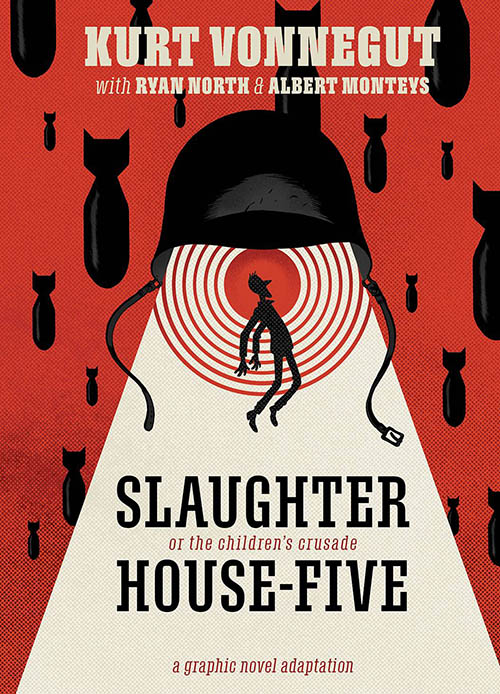
Interview by Troy-Jeffrey Allen and Matt Barham
Does Kurt Vonnegut's Slaughterhouse-Five still carry weight? Even in the 21st century? That's what publisher BOOM! Studios is banking on with the release of their Slaughterhouse-Five original graphic novel. Writer Ryan North (Unbeatable Squirrel Girl) and artist Albert Monteys (Universe!) had taken on the daunting task of adapting Vonnegut's literary classic into (*gasp*) a comic book.
But what does 1969's Slaughterhouse-Five have to say in 2020? We asked Ryan North and Albert Monteys that very question. It turns out that this bizarre tale of war trauma, aliens, and time travel would very much like to have a word with our current year. Read on.
PREVIEWSworld: Why Slaughterhouse-Five now? Why as a graphic novel?
Ryan North: For me, Slaughterhouse-Five is even more vital and relevant now than when it was written, and bringing that story to a new audience - and medium - offered a ton of really satisfying creative challenges. Kurt Vonnegut is one of my favourite authors of all time, and it's been a huge honour of my life to be trusting with bringing his work into the medium of comics.
PREVIEWSworld: Are you zeroing in or unpacking anything differently? To modernize it.
Ryan North: There's some minor tweaks done to language and statistics, updating it with the most accurate numbers and so on. The biggest change is to turn Kilgore Trout, failed scifi novelist, into Kilgore Trout, failed sci fi novelist whose now moved so far downmarket that he's writing comics. It's a fun metajoke about the medium, but it also lets us show his wonderful stories, described in the original prose novel, as full book-within-a-book comics, done in a vintage Golden Age style. They're astounding pages that Albert knocked out of the park, and some of my favourite sequences in the book. The whole goal of the project was to make the story feel at home in the medium, as if it had somehow been conceived as a graphic novel first. That's the guiding light for the whole project, and it's been the reason for just about every choice we've made when adapting the work.
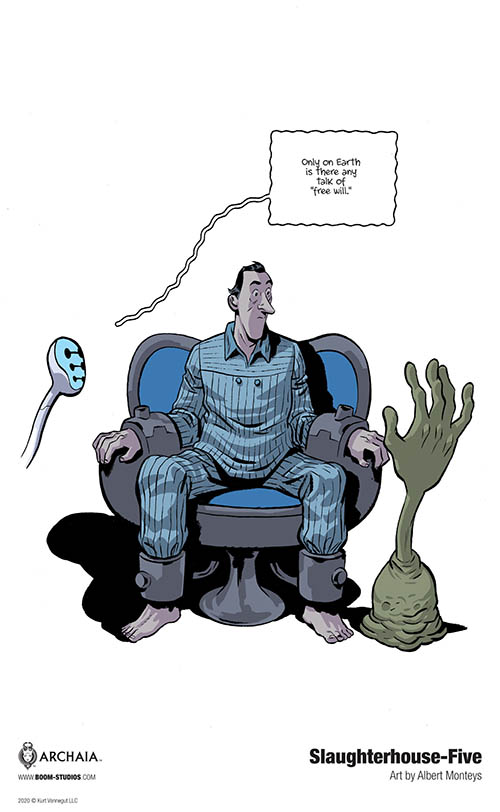
Albert Monteys: Some changes were made, not to modernize it but to adapt it to the comics medium and keep it closer, what a beautiful paradox, to Kurt Vonnegut’s book. Kilgore Trout’s character, for instance, who is a science-fiction writer in the original novel is now a comic-book writer and that allowed us to present the short tales Vonnegut sprinkled through the novel into vintage comic-book pages. That is just one of the many wonderful ideas Ryan had. Basically, the book acknowledges its condition of graphic novel adaptation from page one and that’s a very Vonnegut way of doing things.
PREVIEWSworld: Are you still using Kurt Vonnegut as the initial narrator?
Ryan North: Basically. There's some distance now, because it's "Kurt says" and not "I say", but it's definitely the heart of the book, and Kurt shows up later on too, like he does in the novel. I was a little uncertain of this at the start, but then I listened to an old interview with him where he said most movie versions of books fail because they always lose the main character: the author of the book. And that made me smile and gave me confidence that keeping Kurt there was the right choice. But even if he wasn't, his prose is so simple, so direct, so deep, and so instantly recognizable that he's still there throughout the book. Slaughterhouse-Five is Vonnegut through-and-through.
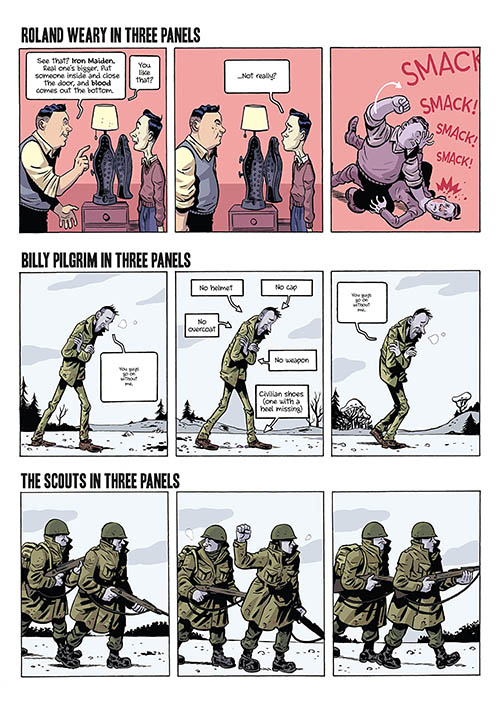
Albert: Did you utilize any of Vonnegut’s sketches for your illustrations?
Albert Monteys: I think one of the things that made Vonnegut’s books so special to me was tha fact that he recurred to cartooning when something was best told this way. All the Vonnegut illustrations that appear in the novel are in the book, one way or the other, sometimes more obvious, some times in a subtler way and I made sure to keep his hand lettering on every occasion. So yes, Vonnegut’s drawings were among the vast pile of reference I had for the book, on top of it all.
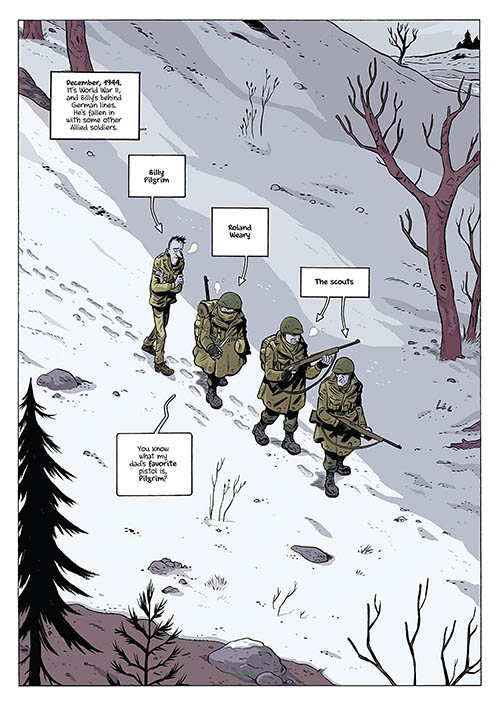
PREVIEWSworld: Tell us about Billy Pilgrim. Why do we follow him through this story?
Ryan North: Billy Pilgrim has come unstuck in time, and we travel with him as he skips throughout his life, from childhood to death, to war and peace and Earth and the planet Tralfamadore and everything in between. Billy's experience of time works well for Slaughterhouse because it kinda reflects how Vonnegut tells the story: he'll tell you what's going to happen, begin the story by telling you how it ends, give you an overview of the whole book, and only then start telling you the story. It's a fantastically compelling way to move through a narrative, and also very visual, which helped us a lot when adapting the book. In prose, when your character hops through time, you have to tell us what era he's in or give us enough detail that we can figure it out. In comics, you know right away from the way the character looks, the clothes he's wearing, and the styles around him. That was a great help when it came time to plot the story!
Albert Monteys: Billy Pilgrim is a very special character in the sense that he doesn’t make a single significant decision in the whole book. He just travels back and forth through his timeline having things happening to him. In one scene of the book Billy reads a novel from the planet Tralfamadore. It’s described as having no linear structure, no moral, no suspense, "just many marvelous moments seen together all in the same instant”. I think this scene gives us the key to enjoying Slaughterhouse-Five.
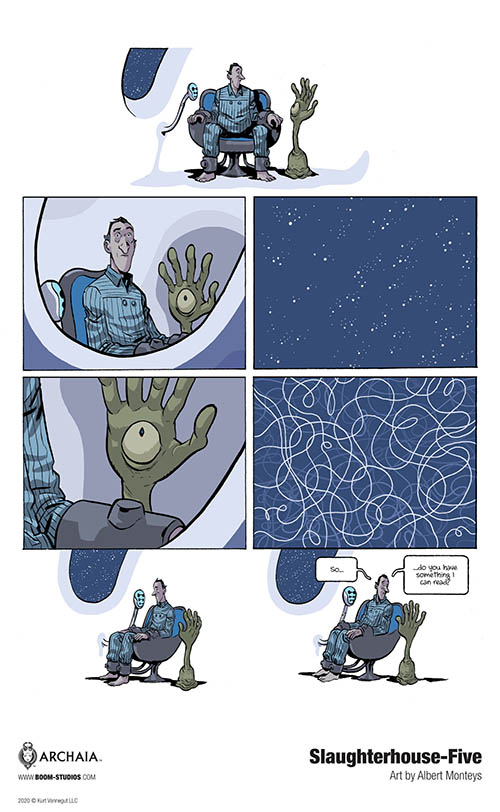
PREVIEWSworld: How did you go about depicting such a non-linear story? I mean, it’s a time travel story in specific ways. But some characters return years later looking completely different. Some age. Styles change across decades…
Albert Monteys: When you think about it, comics are the perfect medium to tell a story like this. Comics are, after all, a series of moments frozen in time, presented to the reader who has the work to make sense out of them. Writers and artists can lead them, make that work easier or harder.
Lucky me, Ryan's script had taken care of a lot of the decisions that give form to the tale. The many different art and narrative styles are described in the script and my work was to make it cohesive enough to work as a single narrative and varied enough to help the reader navigate through those crossing timelines. What I focused on mostly was working on some distinctive features for each period, most of the time using color which is such a powerful tool but also changes in style.
Sometimes the story wants the reader to get lost for a beat, to not know exactly where we are now. Those scenes were maybe the most tricky.
PREVIEWSworld: So how did you two get involved in this project?
Ryan North: It was as simple as our editors contacting me and asking if I liked Kurt Vonnegut, me replying that he's my favourite, and then we took it from there. At first I was terrified, and I'm still a little scared, but also insanely proud of what Albert has produced. It's just a terrific book, and I'm so impressed by it! (I can say that because I didn't draw it, and what I wrote was based on Vonnegut's book, so I've really just got one tiny finger on the wheel here - everyone else did the hard work!)
Albert Monteys: I got an email from Sierra Hahn, BOOM!’s Archaia imprint editor that had “Vonnegut Illustrating Opportunity” as the subject and I couldn’t believe how lucky I was, being a big Vonnegut reader. Then I found out it was Slaughterhouse-Five and my first reaction was “this is impossible to adapt”. When I read Ryan’s script which, I seem to recall, was already completed by then and saw the amount of creativity and great ideas he’s poured into it, making it not only an adaptation but a celebration I was in.
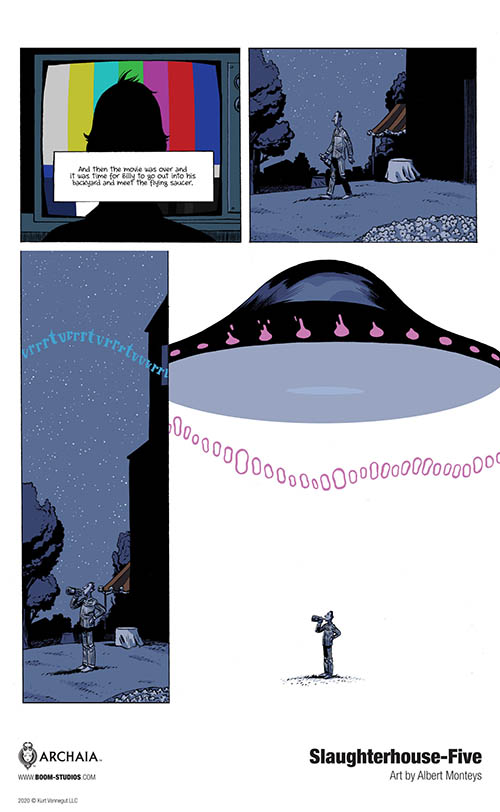
PREVIEWSworld: Is there a moment in the original novel that you were determined to get in the graphic novel?
Ryan North: When I was rereading the book for this project, I remember getting to (and spoiler alert) the part where they see Dresden, after the bombing, and how hard that "So it goes." that comes after lands. It's been a phrase throughout the book, a metronome, and then in that one moment those three words encapsulate so much tragedy and loss and it hits you like a train. So wanting to capture that in comics was something I knew we had to do - somehow - and basically the whole book is structured around making sure we hit that one note perfectly, since to me it's the emotional core of the book - or at least, one of them. It was realized as a double-page spread of Dresden in ruin, echoing an earlier spread of it at its peak, and Albert drew it even better than I'd imagined. It had the same effect on me reading it in comics as it did in prose, which is incredible, because in the comics I knew it was coming.
PREVIEWSworld: What was it like working on something so revered?
Ryan North: Terrifying and challenging and wonderful and incredibly rewarding.
Albert Monteys: I must admit I felt terrified up to a point, because I was one of those who revered the book. Taking something so unique, so full of meaning and retelling it, turning the millions of images Vonnegut conjured in reader’s minds into one single version is such a great responsibility. So what I did, and I think that’s how Ryan tackled it too, was remind myself this book wasn’t Slaughterhouse-Five the novel but North and Monteys’ graphic novel version of it. Some readers may see the book in a different light but I think we approached the book with enough respect to please the Vonnegut fan and enough boldness to add something to it. So far the reviews from Vonnegut readers have been pretty good, that eases my mind.
PREVIEWSworld: Who do you hope reads this?
Ryan North: It's a book that's timeless, and in a sense, kind of ageless too: I know it's been loved by adults and by teens still figuring out what kind of adult they want to be. I think for those of us who've read the original book, it's a terrific way to revisit it and see the story from a new perspective. And for those who haven't, it's a wonderful Vonnegut experience, something new but familiar at the same time. Its message of sorrow and hope and humanism is something that's timeless and relevant, even now.
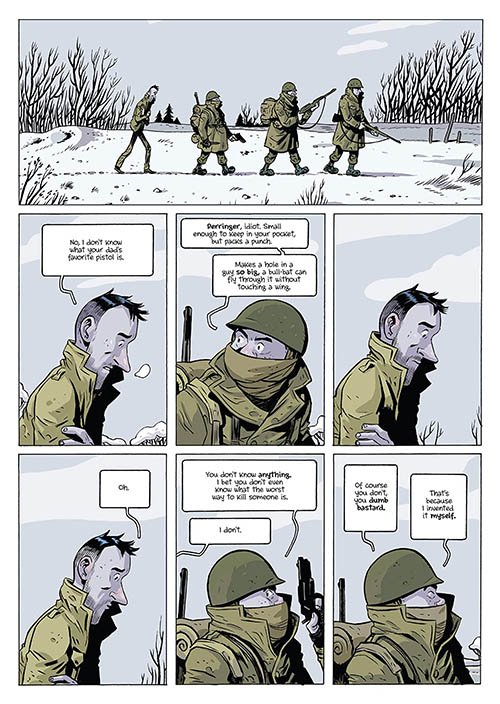
PREVIEWSworld: Is Billy really experiencing time travel or is he dealing with PTSD? Do you think that matters?
Ryan North: For me, I don't think it particularly matters: this is Billy's story, and this is how he's experiencing it, and we're right there with him in every moment. He thinks the Tralfamadorians are real and so, so do we - though we might have some questions afterwards, when we look over what we've seen. But for me the question is less "is this real" and more "what does this mean to Billy Pilgrim", you know?
Albert Monteys: Vonnegut didn’t aswer this one so I don’t think I should. Slaughterhouse-Five, as a piece of literary fiction can be interpreted in many ways, and as a good classic we get texts every once in a while finding new meaning and context to it. I don’t think there is a single key to unlock the book’s meaning and that’s what makes it such a well loved story making readers go back to it once and again. And yeah, it matters, but figuring those things out is part of the fun.
The Slaughterhouse-Five Original Graphic Novel (JUN200780) is available now at your local comic shop.
For more from Boom! Studios, keep an eye on PREVIEWSworld.com's Twitter, Facebook, YouTube, or Instagram.




